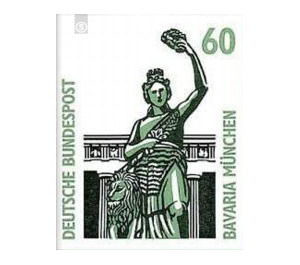Postage stamps: sights - self-adhesive - Germany / Federal Republic of Germany 1991 - 60 Pfennig
Theme: Art & Culture
| Country | Germany / Federal Republic of Germany |
| Issue Date | 1991 |
| Face Value | 60.00 |
| Color | brown white |
| Printing Type | indirect 2-color letterpress |
| Stamp Type | Postage stamp |
| Item Type | Stamp |
| Chronological Issue Number | 1405 |
| Chronological Chapter | GER-BRD |
| SID | 21131 |
| In 74 Wishlists | |
With »Landmarks«, the Deutsche Bundespost replaces the series »Castles and Palaces«, begun in 1976/77. The new permanent series with its unusual representations of significant cultural and technical achievements out, but should also be an incentive to look at the objects once in the original. The supplemental values 10, 60, 80 and 100 Pf for the make mark series appear as self-adhesive stamps in the stamp booklet. The reel stamps appear simultaneously and identically with the inscription "Deutsche Bundespost Berlin". The Hall of Fame with the colossal bronze statue of Bavaria on the hill above the Theresienwiese is probably the most popular and well-known monument in Munich. Its meaning and its history can only be judged from the ideas of its founder: it owes its origin to the romantic patriotism of King Ludwig I, who in Bavaria produced a whole group of monumental buildings of similar meaning. The Walhalla near Regensburg and the liberation hall at Kelheim belong to this triad of patriotic monuments. The complex on the Theresienhöhe was built on behalf of King Ludwig I of Bavaria from 1843 to 1853 by Leo von Klenze »in recognition of Bavarian merit and fame«. Citing the Greek architecture - model was the type of the ancient colossal altar - the hall of fame is designed as a three-winged portico. In this hall, 74 busts of famous Bavarians were set up. In front of the temple of honor, the bronze statue of Bavaria, created after Ludwig Schwanthaler's model, found a place. The casting of this statue, executed by Ferdinand Miller from 1844 to 1850, which weighs 1,560 quintals, was a technical masterpiece that aroused the unrestricted admiration of its contemporaries. (Text: Bavarian Ministry of Economic Affairs and Transport, Munich)


